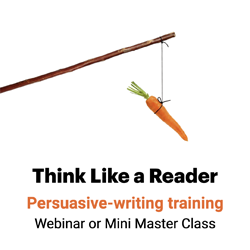Focus on what the reader wants
If you wanted to keep teens from smoking weed, what message might you communicate?

One health organization, reports Guy Kawasaki in his book Enchantment, used the message that young people who smoked weed were five times more likely to engage in sex.
Have you ever met a 17-year-old football player? For that matter, have you ever met a 58-year-old writing coach?
Many humans — except perhaps for those who work for this one particular health organization — actually enjoy sex. I myself have met several people who feel their lives would be much less interesting without it.
Not to say that the five-times-less-sex message wouldn’t work on a different audience. If you were trying to convince parents, teachers or school board members to campaign against teen weed-smoking, then that data point might be compelling.
For most other audiences, though, the promise of five times more sex might just convince the most sober among us to wake and bake, nod off on the couch during all-day “I Love Lucy” marathons and come to surrounded by empty Cherry Garcia cartons.
And that’s the problem with this message: It has a WIIFM, or a “What’s in it for me?”
It just focuses on the wrong M.
Answer your reader’s No. 1 question.
The first thing your reader wants to know from your message is “What’s in it for me?” Advertising writers long ago shortened this term to WIIFM, pronounced “wiffum.”
So think like your readers:
- Your customer readers don’t care that your organization is putting $100 million more into R&D this year. They want to know whether that means their computer will be faster and easier to use.
- Your employee readers don’t care that your organization is adding $10 million to the profit-sharing coffers. They want to know whether that means they’ll be able to retire early.
- Your media contacts don’t care that your organization has launched a revolutionary new toothpaste. They want to know whether it’s going to reduce their own readers’ dental bills.
So answer the reader’s No. 1 question: “What’s In It For Me?”
But first, you need to know who Me is.
Whatever happened to Step 1B?
You remember Step 1B of the five-step communication planning process. It’s “Target your audience.” It comes right after identifying the business challenge and before setting goals for, developing, implementing and measuring the success of your communication plan.
So whatever happened to Step 1B?
I’ll tell you what happened to Step 1B. The internet happened to Step 1B. All of a sudden, we weren’t targeting our readers — our readers were targeting us.
Which meant that instead of targeting anybody, we were suddenly targeting everybody. (And remember what Mom said about trying to please everyone.)
There is a solution to this problem, and it is to have readers target themselves:
- Offer separate doorways on your website. For a health care site, for instance, you might offer doors for patients and doctors — and never the twain shall meet. Understand that if I stumble onto my doctor’s web pages, I will decide that your site is not for me. And if my doctor finds herself on web pages targeted at my level of medical expertise, she will decide that your site isn’t for her. Target each of us, separately.
- Offer separate social media feeds. A river runs through my city, and 14 bridges connect the east and west sides of town. If my bridge is closed, I want the DOT to tweet urgent updates every five seconds. But if your bridge is closed, I never want to hear about it at all. The solution: Offer separate Twitter streams for each bridge.
- Offer separate news releases, tag intranet articles for certain departments, segment email blasts. That doesn’t mean you need to multiply your work. Just finesse the headline, deck, lead and nut graph of each piece to focus on your targeted audience’s needs.
But every day, I work with communicators who don’t do that. Instead of targeting audience members or helping audience members target themselves, they target everyone.
Their every web page is for all comers. Their all-in Twitter streams drown disparate followers in irrelevant messages. Their e-zines and newsletters go to employees, to customers, to legislators.
Even if the WIIFM that would compel one audience would repel the rest. (Remember: sex.)
We need Step 1B. Help me bring back Step 1B!
Because not all of your Me’s are the same. The rich, for example, are different.
The rich are different.
I’m not just saying this. It’s true: While most parents tend to teach their kids to prioritize the needs of the group over their own needs, wealthier parents tend to teach their kids to succeed on their own.
It shows up in charitable giving: Wealthy adults are less likely to share what they have with others.
So how do you get the wealthy to give? Frame their giving as a personal accomplishment, say three researchers.
They found in one study that wealthier people — those with incomes higher than $90,000 — were way more likely to click “Donate today!” when giving messages stressed individual achievement (“You = Life-Saver”) instead of emphasizing a common goal (“Let’s Save a Life Together”).
In another study, alumni from an elite business school gave $150 more on average when asked to “Come forward and take individual action” than when they were asked to join their community to “support a common goal.”
That’s their WIIFM.
That message won’t work for everyone. And that’s OK. It doesn’t have to. You can use the common-goal message with your less wealthy givers.
But do target your audience members and focus on what’s in it for them. That’s how you put the M in WIIFM.
___
Sources: Guy Kawasaki, Enchantment: The Art of Changing Hearts, Minds, and Actions, Penguin Group (USA) LLC, March 8, 2011
Ashley V. Whillans, Elizabeth W. Dunn and Eugene M. Caruso; “How to Get the Wealthy to Donate”; The New York Times; May 12, 2017
Ashley V. Whillans, Eugene M. Caruso, Elizabeth W. Dunna; “Both selfishness and selflessness start with the self: How wealth shapes responses to charitable appeals”; Journal of Experimental Social Psychology; volume 70, May 2017, pp. 242-250

Leave a Reply